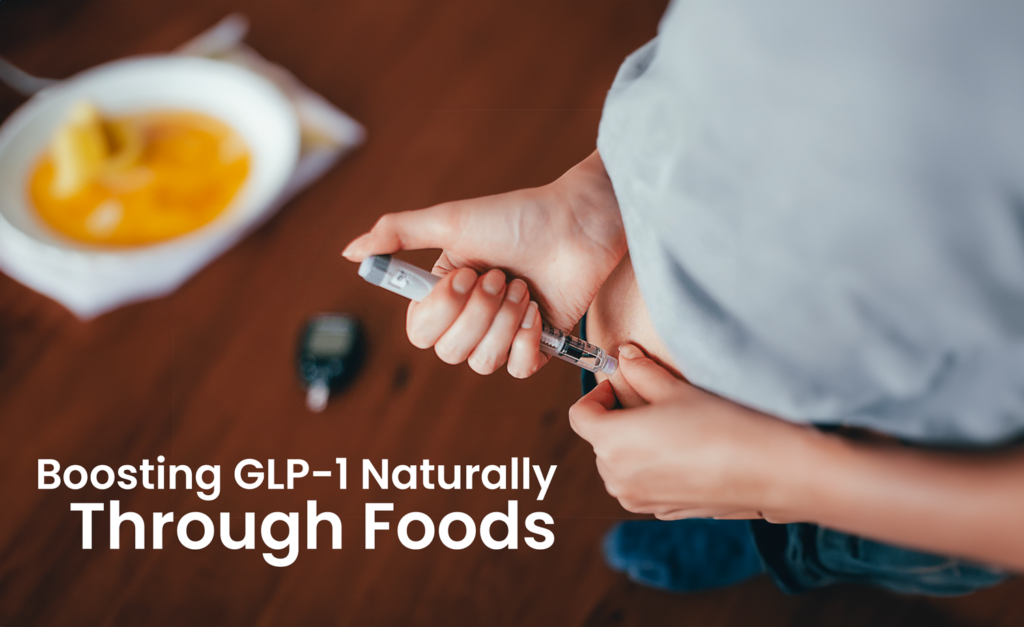
GLP-1 weight loss is becoming very popular worldwide. Many products aim to regulate blood sugar and aid weight loss. Many of these products mimic a natural hormone, GLP-1. It’s made in the human body. Certain brain neurons and intestinal L-cells secrete this hormone after eating food. GLP-1 plays an integral role in blood sugar regulation. By lowering glucagon and raising insulin, it does this. Insulin lowers blood sugar by removing glucose from the blood. It takes it to body tissues for energy and storage. Glucagon, released when blood sugars are low, raises them. It accomplishes this by causing the liver to release glucose.
GLP-1 also slows digestion and contributes to a full sensation. It achieves this by reducing the stomach’s emptying speed. This effect decreases appetite, which lessens food consumption. A side effect of appetite suppression is less food intake. This can improve blood sugar, help with weight management, and improve the perfection of testing blood glucose. One can boost the body’s production of the GLP-1 hormone through natural means. Buckwheat, a food rich in protein and fiber, elevates GLP-1 levels that cause fullness. Let’s explore the GLP-1-promoting foods. They help regulate blood sugar, reduce appetite, and support testing blood glucose levels.
Key Foods For Boosting GLP-1
Foods high in fiber, protein, and healthy fats increase GLP-1 secretion in the gut. Nutrients like fatty acids, monosaccharides, and peptides boost its secretion. These foods are high in these nutrients. They increase GLP-1 hormone levels.
1. Buckwheat
Buckwheat is best for people who are at a higher risk of type 2 diabetes. Buckwheat is a good food for improving health in low-income groups.
Buckwheat has insulin-like compounds. They could help control blood sugar and reduce type 2 diabetes risk by testing blood glucose. Other researchers who are also interested in buckwheat have reported beneficial effects.
Also, buckwheat eaters had lower triglycerides, cholesterol, and LDL than non-eaters. Thus, buckwheat may provide more benefits for the promotion of health.
2. Avocado
Avocados, which are high in fiber and monounsaturated fats, may raise GLP-1 levels. According to a study, eating a lot of monounsaturated fats may increase the release of GLP-1. A study found that eating a whole avocado with a meal raised GLP-1 levels and lowered insulin.
Avocados slow digestion. So, it slows the pancreas’s release of glucose into the blood. This gradual glucose release, in turn, leads to increased GLP-1 secretion. In addition to assisting with blood sugar regulation, testing blood glucose may enhance insulin resistance management.
Mash avocado. Mix in a bit of salt and lime juice. It’s a healthy chip dip or a great toast spread. It boosts GLP-1.

3. Nuts
Nuts, like pistachios, almonds, and walnuts, are rich in fiber, protein, and healthy fats. They may boost GLP-1 secretion. Like avocados, nuts are high in fiber. This slows digestion and insulin release. It also raises GLP-1 secretion.
Nut consumption can boost insulin sensitivity due to its healthy fats. These recommended nuts keep you full longer. They increase satiety and reduce appetite and calorie intake. A great way to add nuts to your diet is to eat a handful as a snack. For extra crunch, you can also add them to your favorite salad.
4. Eggs
Eggs, especially egg whites, are a great source of protein and monounsaturated fats. They increase GLP-1 secretion. One study found that a breakfast of three eggs, not a bagel, led to lower blood sugar levels after testing blood glucose following the meal.
Also, the study participants reported less hunger and food intake over the next 24 hours. To enhance optimum GLP-1 secretion and kickstart your day, try a veggie omelet or a couple of cooked eggs.
5. Grains
High-fiber grains, when fermented in the gut, produce short-chain fatty acids (SCFAs). These include butyrate, acetate, and propionate. SCFAs may stimulate the release of GLP-1 by binding to the L-cell receptors.
Fiber in grains slows digestion. This leads to a gradual release of glucose, which triggers GLP-1 secretion. To support your GLP-1 hormone levels, start your day with a bowl of oats or whole wheat bread. Other whole grains, like barley, rye, millet, and buckwheat, are also rich in soluble fiber. They help with satiety and GLP-1 secretion.

6. Olive Oil
Numerous studies have demonstrated the positive effects of an olive oil-rich diet on GLP-1 levels. One study shows that diets high in olive oil boost GLP-1 after eating. The same study found that diets high in olive oil lower glucose levels after eating and when fasting. They also improve insulin sensitivity.
Use olive oil with your favorite veggies or drizzle it on a salad or deli sandwich. It is a GLP-1 superfood with many benefits.
7. Vegetables
Asparagus, broccoli, artichokes, and celery are high-fiber veggies. They may boost GLP-1 levels and help in testing blood glucose.
A study found that eating veggies before carbs affects GLP-1 and glucose in type 2 diabetes patients. The biggest impact was seen 60 minutes after a meal.
Toss colorful vegetables in olive oil. Sprinkle it with sea salt. Air fry them. This makes a tasty, healthy side dish. It helps with testing blood glucose and GLP-1 hormone levels.
Eat Right Foods to Support Optimal GLP-1 Level
Research suggests that diets that boost GLP-1 could help with type 2 diabetes and obesity. To wrap up, incorporating GLP-1-boosting foods like buckwheat, avocados, nuts, and whole grains into your diet can play a vital role in managing blood sugar levels and supporting weight loss. These foods not only promote a feeling of fullness but also help regulate insulin and glucagon, which are essential for maintaining balanced blood sugar.
However, for those seeking more structured support in managing weight, Direct Preventive Care offers comprehensive weight loss solutions, including the use of medications like Ozempic, Wegovy, and Zepbound. With our expert guidance, you can achieve significant weight loss—up to 20%—through a personalized program that includes both medication and provider care. Discover how Direct Preventive Care can help you manage your weight effectively and safely.














